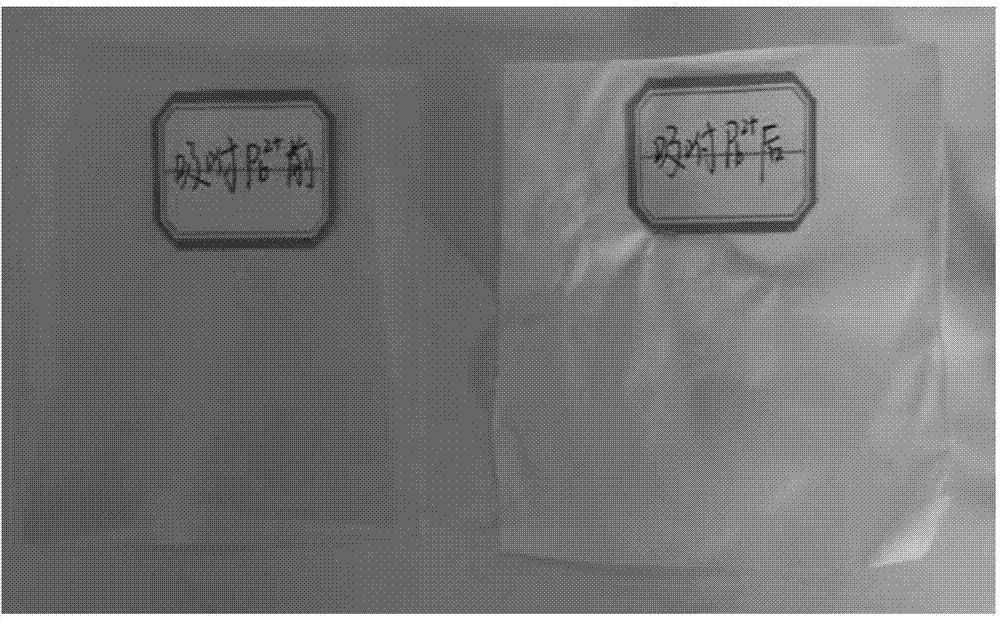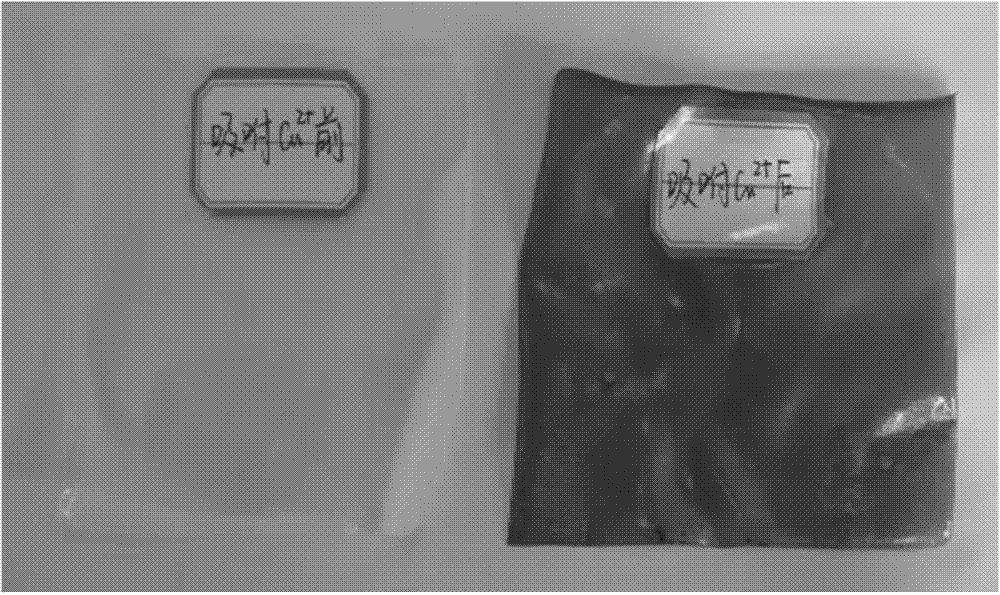Preparation method of hybrid film adsorbent for removing heavy metal ions in water
A technology of heavy metal ions and hybrid membranes, which is applied in chemical instruments and methods, adsorption water/sewage treatment, and other chemical processes. It can solve the problems of easy degradation of chitosan, short service life of membrane adsorbents, and complicated preparation processes. , to achieve the effect of increasing adsorption and removal capacity, convenient use and regeneration, and simple preparation method
- Summary
- Abstract
- Description
- Claims
- Application Information
AI Technical Summary
Problems solved by technology
Method used
Image
Examples
Embodiment 1
[0022] Example 1. Prepare a hybrid membrane adsorbent for removing heavy metal ions in water with the mass ratio of reactants: polyvinyl alcohol: formaldehyde: silane coupling agent = 10:1:1
[0023] First, add 10 g of polyvinyl alcohol (PVA) with a relative molecular weight of 1750 and 90 mL of water to a 500 mL container equipped with a stirrer to prepare an aqueous solution of polyvinyl alcohol (PVA) with a concentration of 10% by mass. The experimental process is as follows: in an air or nitrogen atmosphere, at a temperature of 90 ° C, the mixture of polyvinyl alcohol (PVA) and water in the container is continuously stirred until the PVA is completely dissolved, and then 2.7 mL of formaldehyde with a concentration of 37% by mass is added. The solution is used as a cross-linking agent for the cross-linking reaction; in order to speed up the cross-linking reaction, add 1 mL of dilute hydrochloric acid with a concentration of 0.1M to promote the cross-linking reaction, continu...
Embodiment 2
[0030] Example 2. Prepare a hybrid membrane adsorbent for removing heavy metal ions in water with the mass ratio of reactants: polyvinyl alcohol: formaldehyde: silane coupling agent = 10:1:1
[0031] Using the same experimental device, operating steps and the same batching ratio as in Example 1, the above-mentioned standing defoaming substance is slowly poured onto a clean and dry glass plate to scrape the film, and placed at room temperature for 24h, and then the Put it in a constant temperature drying oven, convectively dry it at 0°C for 24 hours, and remove the membrane from the glass plate after cooling in the air to obtain a hybrid membrane adsorbent that does not contain a support and can be used to remove heavy metal ions in water.
[0032] The experimental results show that: at 45°C and pH=3, its effect on Pb 2+ The adsorption capacity is 0.68mmol / g; under the condition of 45℃ and pH=4, its 2+ The adsorption capacity is 0.79mmol / g, which shows that the hybrid membrane...
Embodiment 3
[0034] Example 3. Prepare a hybrid membrane adsorbent for removing heavy metal ions in water with the mass ratio of reactants: polyvinyl alcohol: acetaldehyde: silane coupling agent = 1: 0.01: 1
[0035] Using the same device and operating steps as in Example 1, under the temperature condition of 0°C, 1g of polyvinyl alcohol (PVA) with a relative molecular weight of 1750 was dissolved in 999mL of water until the PVA was completely dissolved, and the mass percentage concentration of the preparation was 0.1% polyvinyl alcohol (PVA) aqueous solution. Then add 0.25mL of acetaldehyde solution with a mass percentage concentration of 4% as a crosslinking agent to carry out the crosslinking reaction; then add 1mL of dilute sulfuric acid with a concentration of 0.01M to promote the crosslinking reaction, and continue stirring for 18h to obtain a solution. Then gradually add 1g of silane coupling agent γ-aminopropyltriethoxysilane (KH-550 for short) to the solution, carry out sol-gel re...
PUM
 Login to View More
Login to View More Abstract
Description
Claims
Application Information
 Login to View More
Login to View More - R&D
- Intellectual Property
- Life Sciences
- Materials
- Tech Scout
- Unparalleled Data Quality
- Higher Quality Content
- 60% Fewer Hallucinations
Browse by: Latest US Patents, China's latest patents, Technical Efficacy Thesaurus, Application Domain, Technology Topic, Popular Technical Reports.
© 2025 PatSnap. All rights reserved.Legal|Privacy policy|Modern Slavery Act Transparency Statement|Sitemap|About US| Contact US: help@patsnap.com


